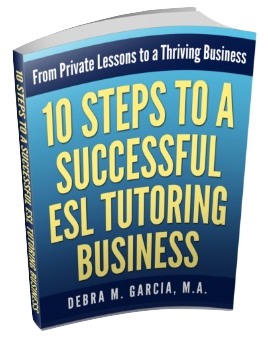Teaching Future Simple Tenses
to ESL and EFL Students
Teaching Future Simple Tenses can be confusing for ESL teachers and for students. This is because there are actually two "versions" of the Simple Future that need to be taught: will and be going to.
This page focuses on the use of "will" to express the future.
Resources for teaching "be going to," and also the use of the Present Progressive for the future, are listed at the bottom of this page.
As with all tenses, verb "conjugation" is only one part of the lesson. The "form" and the "function" must also be taught. This page discusses these three elements to help you prepare your ESL Future tense lesson plans.
Please note that "Future Simple" is interchangeable with "Simple Future." The name will depend on the teacher and/or the English grammar book.
Verb Conjugation
The Future Simple is pretty easy to construct. Here's how:
- subject + will + base form of the verb
Here are some examples with miscellaneous common verbs using the subject pronouns I, you, she/he/it, they, and we.
- I will talk. I will walk. I will dance. I will sing.
- You will talk. You will walk. You will dance. You will sing.
- She/He/It will talk. She/He/It will walk. She/He/It will dance. She/He/It will sing.
- They will talk. They will walk. They will dance. They will sing.
- We will talk. We will walk. We will dance. We will sing.
Future Simple Verb Form
(five forms the ESL/EFL student must learn)
- Affirmative Usage (I will study. You will study. She/he/it will study. They will study. We will study.)
- Negative Usage (I will not read. You will not read. She/he/it will not read. They will not read. We will not read.)
- Yes/No Questions (Will I teach English grammar? Will you teach English grammar? Will she/he/it teach English grammar? Will they teach English grammar? Will we teach English grammar?)
- Short Answers (Yes, I will. No, I won't. Yes, you will. No, you won't. Yes, she/he/it will. No, she/he/it won't. Yes, they will. No, they won't. Yes, we will. No, we won't.)
- WH- Questions (e.g., When will she teach more verb tenses? Where will you eat dinner? Who will win the lottery? When will we study vocabulary? How will the movie end? Why will you be there?)
Function of Future Simple Tenses
The Future Simple tense has two functions:
- To talk about something that will or will not happen in the future (e.g., I will never retire from teaching ESL to adults.), and
- To express willingness (e.g., Mary: "Someone is knocking at the door." John: "I'll get it.")
ESL Student Challenges with Simple Future Tenses
English language learners normally have trouble with knowing when to use "will" and when to use "be going to."
Using the Present Progressive/Present Continuous for the future is also sometimes a challenge for students studying the Future tenses. They tend to forget that they can use the Present Progressive with a future meaning.
Conjugating and forming this tense using "will" is usually pretty easy for students.
Additional Teaching Resource
I regularly use Azar's Understanding and Using English Grammar when teaching Future Simple Tenses to my high intermediate and advanced students. It's a great teacher resource and also provides explanations and exercises for my adult ESL students.
Related Articles
See my "will" and "be going to"
page for tips on teaching the distinction between these two types of
future simple tenses, and also for a more detailed discussion about "be
going to."
Usually, the Present Progressive tense used for the future (e.g., "I am studying tonight") is the first part of teaching the Future to English Language Learners. See my Present Progressive page for tips.
For a thorough discussion on how to teach verb tenses, see my article on Teaching ESL Verb Tenses.
From Future Simple Tenses to Teaching ESL to Adults


New! Comments
Have your say about what you just read! Leave me a comment in the box below.